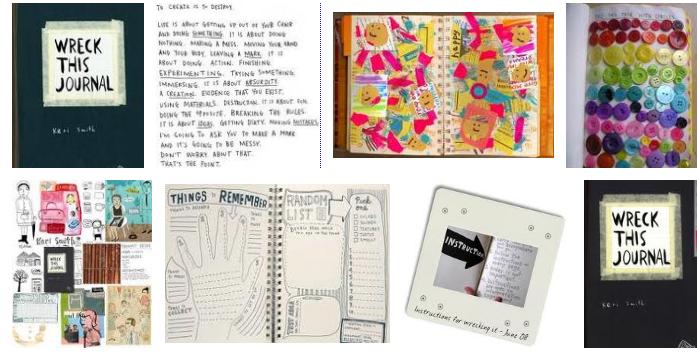This is not a book
A fair part of the Internet activity is spend by surfing and reading the private findings of others about the cool stuff in live. Random strangers with a talent of writing tell us by blogging little stories of their daily lives what to watch, read and share online. In his book Zero Comments Geert Lovink writes among other things, of how blogging relates to dairy writing. Since the wide spread of the Internet and the coming of web 2.0. media, it is now possible to get your diary published public online. As a journal writer who is not able to write her own handwriting, I want my notebooks to stay spotlessly neat and clean, and not to get smudged in any kind of way. Just pointing out another advantage of blogging –no ink stings at WordPress- blogging as a form of online journal writing, seems the perfect way to go.
With this in mind, my attention was drawn to Keri Smith’s Wreck this Journal. This book is not a regular kind of journal containing of white plain pages to be written on. With this book the author instructs her readers to express themselves by massing up their copy in every way possible. Such as by poking holes in pages, tearing random parts of the book and even by scraping it along the ground. According to Smith to create is to destroy, as the subtitle says, apparently much is been created by wracking this journal. A simple Google query gives an insight of the popularity of this spur of creativity by destroying of personal journal copies.
From Facebook fan pages, colourful Flickr uploads to personal YouTube instruction video’s; seeing a guy dragging his journal on a string trough the gutter may seem like a good laugh, wrecking a journal is a serious business of expressing creativity.
In the follow-up of Wreck this Journal, titled This is not a book, Smith takes the idea of creating by destroying to the next stage. Doing so, Smith supports of questioning the meaning of the books existing in the lives of its readers, by challenging them to think of the different purposes this book can have in their lives and the different ways this journal can be used by them. In this way readers are motivated to share their findings online by posting pictures and comments to the website and other social media sites such as Flickr.
By bringing these hard copy journals to the Internet, this not-so-called-books hit the mark of becoming a blog by entering the sphere of the virtual. According to Lovink a blog is the voice of a person related to the online-self; it relates to the questions of who you are and how you present yourself. As Lovink puts it, blogging is a term that express the productive contradiction between the public and private in which bloggers find themselves. Writing and being creative with your personal dairy leads the way of answering those questions and share it with everyone who is willing to listen. The journal functions here as presentation of the offline self shared in an online environment just like blogs. Presenting the offline self by extending to the virtual world where one can be itself; since every person is unique no wrecked journal is the same.
It seems like the voice of the journal wrecker is now linked through social media, in sharing a happy fuzzy feeling of creative inspiration amongst other souls. It makes me want to be a part of this creative expression of journal molestation and smudge something.
